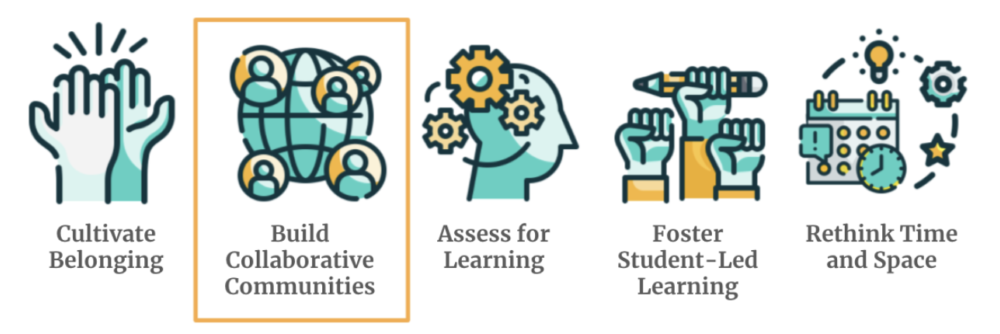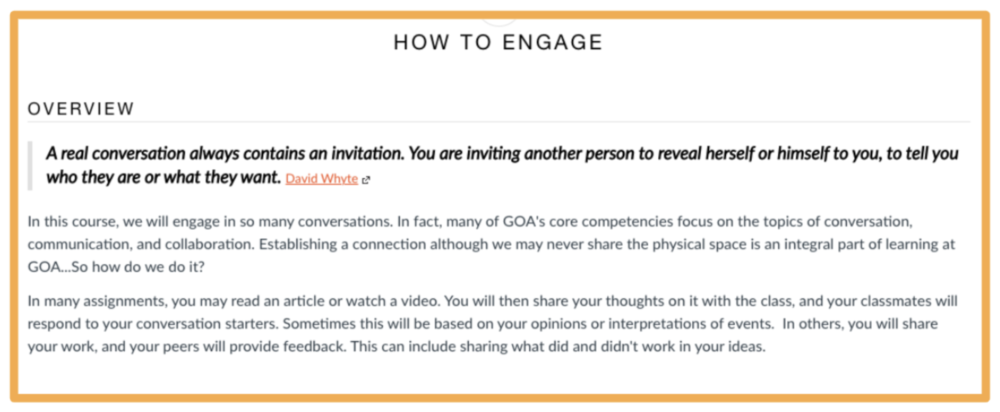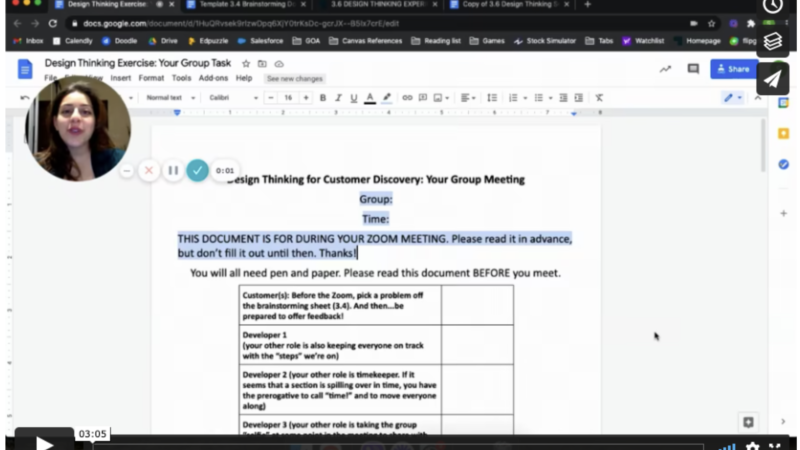How to Build Collaborative Communities: Shifts and Strategies for Teachers
“Students gain collaborative skills by contributing to the learning and work of others and building upon each other’s ideas to co-create...not by just dividing and conquering tasks to complete the final product.” -Aaron Eisberg, Why Collaboration is More than Group Work
Designing for collaborative communities invites a new definition for what we mean when we talk about collaboration. For many of us, in our own experiences as students and sometimes in our own classrooms, collaboration is equated with group work for project completion. While that may serve a purpose, a process-focused approach is what builds and fosters collaborative communities. At GOA, we’re defining collaboration as students engaging in meaningful and transferable processes together--processes that impact learning and that promote cultures of trust, care, and high expectations. The question we’re asking is, how can we empower students to support one another in meaningful processes and thus in gaining essential collaboration skills?
As the second blog post in a five-part series on GOA’s Educator Competencies, we aim to define what it means to build sustainable collaborative communities and offer considerations for actions educators can take.

Begin With Belonging
“In an identity safe classroom, teachers realize that academic learning is dependent on students having an authentic sense of belonging and well-being.” Becki Cohn-Vargas, EdD., Identity Safe Classrooms Part Two: Child-Centered Teaching
Collaboration is made possible in communities that intentionally foster belonging. Cultivating and nurturing our classroom communities creates space for students to take risks as learners and to engage in learning processes. Dr. Dena Simmons shares, “building the type of community we want takes careful thought and hard work; it involves ensuring that all voices are valued, included, and protected and that none are excluded, ridiculed, or threatened.” In the first post in this series, Bonnie Lathram unpacked some of that hard work in cultivating belonging, starting with the need for students to experience human connection. Prioritizing greetings, centering relationships, and checking in on wellness are practical starting points with big impacts on students having the conditions they need to meaningfully collaborate. As Greenhill School educator Joel Garza shared in a recent GOA event, belonging begins with deliberate opportunities to “turn and learn from one another.” In order for students to collaborate effectively, we must design for belonging with intention.
In GOA’s Intro to Psychology course, that intentional design work looks like students guided through an assignment on what it means to engage prioritizing personal connection:

Prioritize the Process
“Participatory cultures remind us that creativity isn’t a solitary endeavor. It is nearly always to and from a community. Great ideas rarely happen in isolation. Instead, they are a part of the constant sharing back and forth of what we are learning, doing, and making. “ -John Spencer, Students Should Share Their Process, Not Just Their Product
Collaboration at its best looks like communities coming together in ways that make everyone’s learning stronger. This starts with engaging students in processes together and structuring those experiences in ways that invite all all students to participate:
Offer frameworks for engaging in discussions.
Craft peer-to-peer feedback opportunities guided by clear learning outcomes.
Engage students in problem solving experiences (like the design thinking example below).
Build in time for students to brainstorm ideas and build off of one another’s thinking.
When students experience processes together--rather than just taking on roles for project completion--they practice collaborative skills that have enduring impacts. They develop skills that apply far beyond our individual classroom walls. They also move one another’s learning forward, uniting in support rather than competition. Learning and relationships both deepen.
In GOA’s Entrepreneurship in a Global Context course, students collaborate on a design thinking exercise, not with the goal of one intended final product, but with the hope that in experiencing a relevant process together, students are then empowered to apply that process to future endeavors. In this short overview video, GOA teacher Suzanne Ayoub sets the expectations for embracing the process:
Entrepreneurship in a Global Context: Design Thinking Overview
Examine for Equity
“Our education system needs to value the many motivations that students bring to their learning, and provide multiple pathways and multiple means of demonstrating learning to ensure students have meaningful choices in creating their future” -Chris Sturgis and Katherine Casey, Designing for Equity: Leveraging Competency-Based Education to Ensure All Students Succeed
Shifting collaboration from a shared group project on a single, assessed product to a shared process aligned to individually assessed outcomes invites students to take risks together as partners on the learning journey. The stakes are not on the grades one another will receive--but on the ways students can support one another towards growth. Designing collaborative communities that focus on process is an essential shift in designing for equity.
In How Teachers Are Changing Grading Practices With an Eye on Equity Joe Feldman, author of Grading for Equity, shares, “We want people to collaborate well because when you collaborate well you make a better product and there’s a great reward to doing that work. We think it will increase their individual learning. The only way to know if they were effective in their group work is to see if they improved in their individual learning.” Shared grades for group work impede accuracy in reporting on individual learning gains and also create potential barriers to community well-being. Shifting from group grades to an approach where groups offer one another input on their learning processes (brainstorming, feedback, problem solving) but where students are individually assessed on their learning gains equips a community to collaborate supportively while following their individual learning pathways.
Inviting student reflection after a collaborative exercise creates space for students to metacognitively reflect on their growth as a collaborator as well as their individual next steps for meeting learning outcomes. In GOA’s Creative Nonfiction course, following peer feedback sessions on writing, students complete their own individual self-reflection on process contributions and then submit their own completed writing drafts, assessed on an outcomes based rubric. The peer-led process leads to intentional revisions and yet maintains the integrity of each individual’s grade.
Conclusion
Building collaborative communities is ongoing work with powerful implications for equipping students with collaboration skills that transcend our classrooms. When we take steps to cultivate belonging and then design intentionally for collaboration, we begin the steps towards more student-led and student-centered learning.
We invite you to join a live conversation on what collaboration means and how to foster collaborative communities. GOA is hosting an upcoming Zoom event, “Ask Me Anything: How Do We Build Collaborative Communities?” on December 8th at 2pm EST. Please register here to join the discussion.

